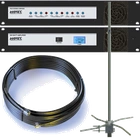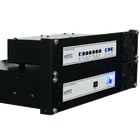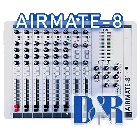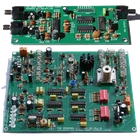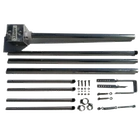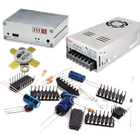D&R Airmate-8. Perfect Console for Start Ups and Professionals
Airmate 8 Radio Console
Over the last 25 years this model has become the defacto standard for start ups, but not only start ups, professional long standing broadcasters too. This is due to it's front fader panel being laid out efficiently with all the controls in the right place. A lot of thought went into the design of this.

|
LIMITED WARRANTY |
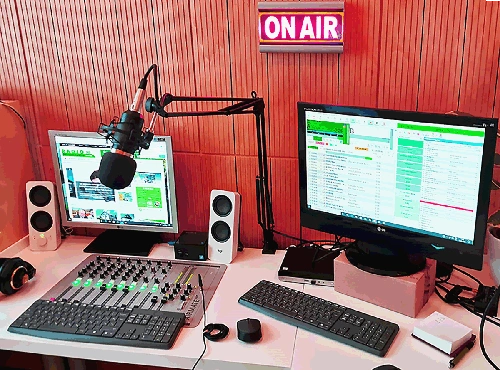
Do You Have A Question?
| INPUTS | |
| Mic inputs | Bal 2kΩ XLR |
| Phantom | 48 volt |
| Noise | -122 dBr (A-weighted) |
| Sensitivity | -70dB min OdB max |
| Insert | -10dBv in/out |
| Line inputs | Unbal 10kΩ |
| Gain | Range of 40dB |
| Phono inputs | Unbal 47kΩ 5mV |
| TELCOS | |
| Connectors | RJ-11 phone line/dialler |
| Mix Minus rejection | @1kHz -60dB |
| OUTPUTS | |
| Left/Right | +4dBu bal XLR |
| Monitor/Aux | +4dBu unbal |
| Cleanfeed/Announcer | +4dBu |
| Tape out | -10dBv unbal |
| Headphone | 16-600Ω |
| Announcer | 16-600Ω |
Mic ON Studio Speaker Muting
In line with all professional radio consoles, the Airmate mutes the studio speakers to silence when the mic fader is pushed up or switched on. Experienced radio presenters are accustomed to this. For newbies, this serves two main functions:
1. As soon as the people in the studio hear the music suddenly go off and there is silence, they know without question the mic is live on air and they must stop talking and chatting and;
2. It stops feedback from the speakers to the mic and prevents any horrible oscillation and squealing
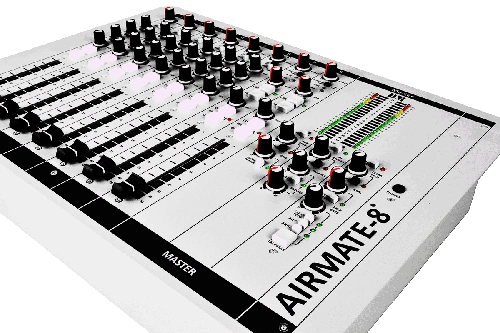
Mic ON Relay (for ON AIR light)
Another essential feature of a radio console is the ability to switch an ON AIR sign on when the mic is switched on. On the back panel of the Airmate there is access to the connections of a small relay that can be wired into any type of light by an electrician. If it's an LED ON AIR light, the Airmate relay will switch it directly provide the extra current required. We have helped countless radio stations install the their ON AIR lights over the last 20 years, if you buy this unit, we will help you too, not a problem.
Clean Feed
Yet again another absolute essential feature that differentiates a radio console from any other type like they use for bands or DJs in night clubs. I think it would be fair to say that any console that does not have clean feed, is not a radio broadcasting console. Clean Feed is separate output made available on the back panel which is the console final output minus the audio from the inputs that are used for the telephone calls. This is absolute necessary if you want to connect to equipment that takes public telephone calls on air.
We have seen so many customers in the past buy these big fancy night club DJ mixers, thinking they have a great deal and they have saved money, only to realise, they cannot take calls ON AIR because they have no Clean Feed. They are never happy when we say you've lost your money, you should have purchased an Airmate or other console with Clean Feed.

Eight Channels
The back panel might look a little daunting, but when you get used to it, it's very straight forward. All eight channels are available in stereo for standard line in. Six channels can be switched from the front panel to function as mic channels. Four channels from the front panel can be switched to allow four more stereo line ins in addition to the existing eight. Channels number 5 and 6 can switch to function as plug n play USB inputs, these are perfect for connecting to two computers. The function of ohannels number 7 and 8 can be switched to take calls LIVE ON AIR. At the point of ordering you decide if you want:
1. Two Telcos
Telcos connect to conventional telephone lines;
2. Two VoIPs
VoIPs connect to a digital type phone system;
3. One Telco and One VoIP
Basically one of each
Any AC Voltage
The Airmate will work on any voltage in any part of the world, 110, 115, 120, 220, 230 or 240 at 50 or 60Hz. The power consumption is super low, to put it in perspective, it's much less than a domestic television. The Airmate complies with all the worlds safety and EMC standards and is CE marked accordingly with a declaration of conformity.

 +1 829 698 0733
What Do You Need? Talk To Us
+1 829 698 0733
What Do You Need? Talk To Us
